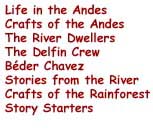

|
Tuesday, August 10, 1999
This morning we woke up early and saw the ranger station for the first time. The station is located about 150 miles upriver from Iquitos. The ranger probably appreciated our company last night. This past year a group of poachers killed three of the rangers assigned to this station. The poachers were angry because they had been fishing illegally in the reserve and the rangers had confiscated their fishing net. People are allowed to catch fish to eat, but they may not to sell them outside of the reserve. Also, certain species at certain times of the year are off-limits to fishermen and so are certain types of nets. The ranger is nervous that since he was one of the men who confiscated
the net, the poachers may come back At 6:00 a.m. most of us went out in one of the small skiffs for two hours of bird watching. Despite the early hour, no one complained and no one was late. The effort to get up early was well worth the treat which was in store for us. There are over 300 species of birds in the reserve. In less than a couple of hours our guides helped us to identify 44 of them. It was the first time that many of us had seen the yellow-headed parrot, slate-colored hawk, or tui parakeet outside of a pet shop or zoo. Everywhere we looked we saw birds.
Although we have seen a lot of dolphins, it is difficult to get a good photograph of them. Unlike ocean dolphins, river dolphins don't often breach. Tamara jokes that the dolphins somehow know when our backs are turned and when the cameras are turned off. Even though the equipment is acting a little "funny," we have managed to work around all the little mishaps. Keeping all the batteries recharged is a continual challenge, though. Also, we can't always keep our connection to the satellite. We often have to switch to another satellite rather than the one above in mid-transmission. Other times it is raining when we are ready to transmit and we have to wait for it to stop. Our roles within our volunteer group are beginning to become clear. Lilia, who is from Venezuela, has emerged as the philosopher and keeps everything in perspective for us. Bill, from North Carolina, keeps us laughing. Terry and Marty, from Nebraska, along with our naturalist guide Béder, are our bird experts. Pat is a great dolphin observer and Sally keeps us in touch with why we all have chosen to participate in the research. We are in day three without our luggage and we no longer know whose clothing we are wearing. Everyone has been so generous with what little we have. Many of our emails have asked if it is dangerous here. For us who don't know the forest, it can be dangerous. We don't know what to look out for or avoid. For people who have lived here their whole lives, however, the forest is their home. They feel safe and protected here. As we move upstream we often see small children swimming and bathing in the river with only the watchful eye of a slightly older brother or sister. Children are taught at a young age what to be careful of and what to avoid. This afternoon we swam with the dolphins . . . and the flying fish . . . and the little fishes that kept biting our fingers and toes. . . . What a glorious day!
|




